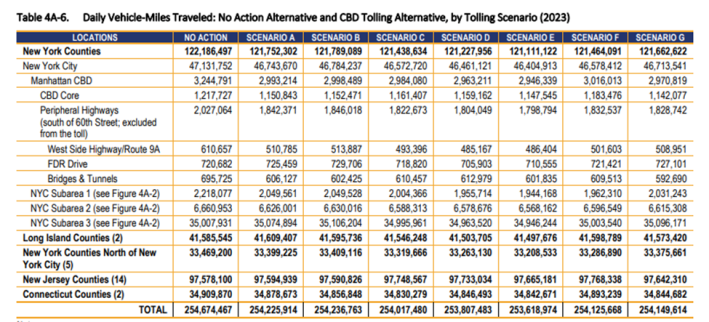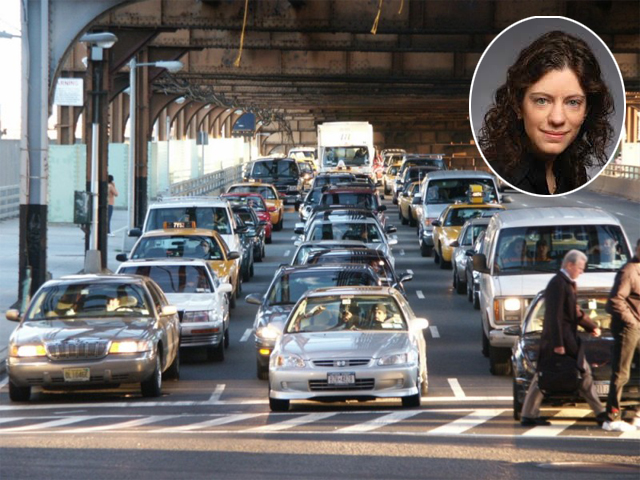It’s natural that transportation and transit advocates who have spent years, if not decades, advocating for congestion pricing would accentuate the positive and minimize the negative in responding to the Metropolitan Transportation Authority’s massive enviro-document dump last Wednesday. There are a lot of positives: Raising $1 billion annually and reducing vehicle miles traveled within the Manhattan central-business district by 7.1 to 9.2 percent is not nothing.
But there are also a lot of potential negatives. Even though none of the negatives outweigh the need for the implementation of congestion pricing, we should all advocate to use the federal environmental review process the way it’s meant to be used: to understand and combat the few negatives. Here they are:
One: A last-minute exemption for public employees driving their private cars to work, or anywhere else in core Manhattan, would decimate the congestion benefits of this program. In the environmental assessment’s executive summary, the MTA notes that “reduc[ing] government-issued parking permits” alone would meet congestion pricing’s two non-financial objectives — reducing the number of vehicles and the number of vehicle miles traveled within Manhattan’s core — below 60th Street.
This finding runs parallel to previous research conducted by Bruce Schaller, who found for a 2007 paper that “government workers, many of whom have free parking, are twice as likely to drive to work in the Manhattan CBD as private sector workers (27 percent compared with 14 percent)."
The six-member Traffic Mobility Review Board that will determine the program’s exemptions will be under immense pressure to allow government workers to continue driving their own vehicles to work — without paying the congestion toll. Such an exemption would destroy the congestion-reducing benefits of business-district tolling, and transform the program into a tax on the private sector. This risk is quite real.
[Editor's note: Streetsblog's Dave Colon wrote about The Bronx issues today. Rep. Ritchie Torres will have a press conference Monday in the South Bronx on the topic.]
Two: Congestion pricing, as contemplated, burdens the Bronx, including, in one scenario, pushing mid-day traffic volumes on the Cross-Bronx Expressway up by 5 percent. The MTA’s environmental assessment is incontrovertible: Under most of the central-business district tolling scenarios the MTA has presented, congestion pricing would result in higher vehicle-miles traveled in the Bronx. So as not to be accused of cherry-picking, herewith is an extensive quote from the MTA’s report subsection here (bold and underline mine):
As a result of diversions, average daily traffic and congestion would increase in certaincorridors outside of the Manhattan CBD. In the Bronx, VMT would increase across Tolling Scenarios A, B, C, F, and G, with all the increase in VMT in the tolling scenarios occurring on highways (in each direction of travel) and ramps while local streets would have less VMT. In Tolling Scenarios A, B, C, F, and G, VMT in the Bronx would increase for personal vehicles, while VMT for commercial trucks would increase in all tolling scenarios except G (Table 4A-28). … Increases in VMT in the Bronx would be driven largely by increases in VMT on the Cross Bronx Expressway between the Alexander Hamilton Bridge and the two Long Island Sound crossings (Whitestone and Throgs Neck Bridges). Personal vehicle VMT would comprise most of the VMT increases on the Cross Bronx Expressway, with commercial truck VMT contributing roughly 25 percent of the overall VMT increase in all tolling scenarios (Table 4A-29). On Bronx highways other than the Cross Bronx Expressway, VMT would increase in Tolling Scenarios A, B, F, and G. All tolling scenarios with crossing credits would have lower VMT changes than Tolling Scenarios A and B, and Tolling Scenarios C, D, and E would have a decrease in VMT on other Bronx highways.”
The numbers that the MTA presents are clear. In all scenarios except for “G,” under which car and truck tolls in the central business district would be identical, the Cross-Bronx Expressway would shoulder between 170 and 704 more trucks each day. These additional trucks represent an increase ranging from 0.6 percent to nearly 2.5 percent.

In one scenario, the Cross-Bronx would face a burden of more than 5 percent more vehicles at the midday peak hour. Again, I will quote extensively:
During the midday peak hour, traffic volumes are projected to increase by approximately 826 vehicles on the George Washington Bridge, which would be an 8.8 percent increase over existing volumes. Approximately 146 vehicles would be added to the Henry Hudson Parkway, 350 vehicles to Harlem River Drive, 110 vehicles to the Major Deegan Expressway, and 220 vehicles to the Cross Bronx Expressway westbound. It is expected that delays and travel times along these roadways would increase during the MD peak hour. Along the Cross Bronx Expressway and the Trans-Manhattan Expressway, the increases in projected volumes would be considered an adverse effect under the volume increase criteria of greater than 5 percent used to determine adverse effects under SEQRA. Adverse effects that would arise if Tolling Scenario D or another similar tolling scenario were implemented will be minimized through implementing Transportation Demand Management measures such as ramp metering, motorist information, signage, and/or targeted toll policy modifications to reduce diversions.”
Of course, the MTA might not choose this scenario. But that is the point: We don’t know, and Bronx residents deserve to know for certain, one way or the other, in a timely fashion.

A rejoinder to these figures might be that highways, not local streets, will bear this additional burden. Yet the problem with many Bronx highways and ramps is that they are poorly built, cutting through dense residential neighborhoods. Additionally, the MTA analysis assumes that the City of New York will enforce truck routes, when enforcement is currently inadequate.
Congestion pricing as contemplated, then, does not expunge New York City of its original sins of geography and urban planning: vehicles that cannot go through Manhattan must go around it. New York’s previous, de-facto mass-scale diversion of vehicles from Manhattan to the Bronx came via the construction of the Cross-Bronx Expressway in the 1950s and the cancellation, roughly a decade later, of two planned expressways across mid-Manhattan and Lower Manhattan respectively.
COUNTERPOINT: CHARLES KOMANOFF TAKES DOWN THIS COLUMN
Transit advocates seem not to want to discuss at all the fact that people living along the Cross-Bronx corridor, who must currently endure horrific noise, pollution, illegal vehicle diversion, and spillover traffic crashes, will endure slightly more of the same under this congestion plan. Already, Bronx Rep. Ritchie Torres has said that though he supports congestion pricing in principle, “any plan that threatens to intensify diesel truck traffic on the Cross Bronx Expressway would raise serious concerns about public health and racial equity.” Mychal Johnson of South Bronx Unite has said that “reducing traffic congestion elsewhere in more economically affluent areas to dump more traffic in overburdened South Bronx Environmental Justice communities is just the type of racist intentional planning that must stop.”
One would hope that the city’s transportation and transit advocates would resist any attempt to minimize the fact that, once again, the Bronx is called upon to accept a congestion and pollution burden to the benefit of Manhattan. Whether this issue is a make-or-break issue, it must be clearly acknowledged — one cannot weigh costs vs. benefits if one does not clearly acknowledge the real costs.
Three: Congestion pricing, as envisioned, doesn’t result in a game-changing reduction of traffic in the long term. Within New York City, the daily vehicle miles travelled in 2023 would be 47.1 million if we don't enact congestion pricing. Congestion pricing would represent a 0.7 to 1.5 percent decrease in traffic during its first year. By 2045, however, vehicle miles traveled under any congestion-pricing scenario would be between 48.9 and 49.4 million vehicles daily. This projection represents a reduction from the “no action” plan for that year — albeit a minor one — of between 0.8 percent and 1.7 percent. It does not represent a decrease from today’s traffic levels. Within New York City, traffic would rise between 3.8 and 4.9 percent from the 2023 “no action” level.
Even within the Manhattan central business district, traffic, by 2045, would comprise between 3.1 and 3.2 million VMT daily under the congestion-pricing scenarios proposed, a reduction of between 5.9 and 8.8 percent compared to that year’s projected “no action” base level, but a reduction of just 3.1 percent, at most, from the 2023 “no action” level.

Four, congestion-pricing revenue won’t result in life-changing transit improvements. It is time to be hard-headed about the massive, open-ended deficits the MTA faces as ridership remains plateaued at 60 percent of pre-COVID normal. The MTA faces a $2.5-billion shortfall for each of 2025 and 2026. With inflation running just below double digits annually, the MTA’s unions are certain to ask for raises that will cost upwards of $1 billion in extra revenue each year, from a current base payroll, across agencies, of $5.6 billion annually. Absent double-digit cost reform across the MTA’s workforce, the idea that congestion-pricing revenue is secured in a “lockbox” for infrastructure investments, as opposed to day-to-day operations, is a fantasy — as is the idea that we are going to use any of this revenue to mitigate the impact on the Bronx.
Five, the city of New York is missing an opportunity to dynamically manage its streets. The MTA’s menu of potential tolls envisions a “peak hour” that (in all but one scenario) lasts 14 hours each weekday. The city is thus foregoing an opportunity to use pricing as a more precise tool to manage traffic, raising the price on theater matinee days, for example, or during the specific hours that people drive to and from work in the greatest numbers. The city is also losing an opportunity to raise the price on air-quality alert or storm days. The MTA, too, is losing an opportunity to, for example, couple higher prices on air-quality alert days with fast-expiring coupons or rebates for use on mass transit, to nudge people who regularly drive into trying the train or the bus once.
One might argue that we can always fix this problem later — but this uncertainty is the peril of starting off the program locked into a now-decades-old philosophy, a fixed-price cordon toll, and putting it under the administration of a state-run authority accountable to the governor, not the mayor — an authority that hasn't proven itself to be flexible, nimble, and politically risk-taking, and an authority that must undergo months of new public hearings and political criticism to change the model later.
None of these factual analyses are arguments against congestion pricing. They are arguments in favor of using the five-decade-old federal environmental review process in the way environmentalists, two generations ago, meant for it to be used. Congestion-pricing advocates did not know, before the MTA released its environmental documents last week, that the long-term result of this particular iteration of congestion pricing was a reduction in core Manhattan traffic of barely 3 percent from today’s levels, and that the improvement to city-wide traffic would be essentially negligible. Advocates did not know that the near-term and long-term result was more trucks in the already truck-crammed Bronx.
It is perfectly fair to conclude that despite these drawbacks, this menu of options is the best, politically speaking, that New York is going to get, and so the long-term benefit to Manhattan and to the city as a whole, however mild in the latter respect, is worth the very real cost to the Bronx.
It is also perfectly fair to conclude that this plan is not good enough, and that there is still plenty of time to fix it; that is, after all, what the environmental-review process is for. The only foolish choice is to refuse to consider these facts at all, because they get in the way of congestion-pricing advocacy.
Nicole Gelinas (@nicolegelinas) is a senior fellow at the Manhattan Institute and a New York Post columnist.







